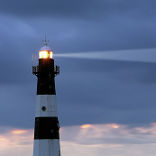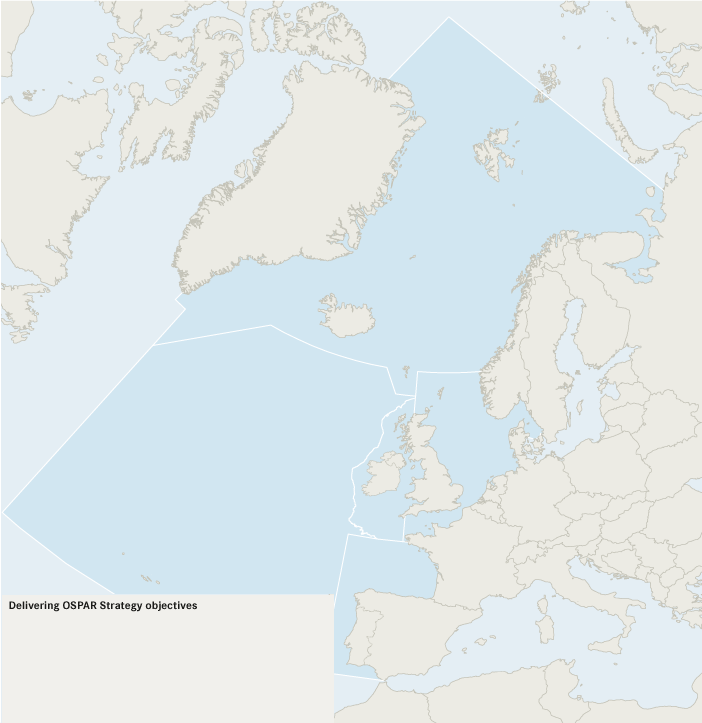Welcome to the QSR 2010!
Human activities at sea and on land as well as the emerging threats of climate change put considerable pressures on marine ecosystems. The QSR 2010 is a milestone for evaluating the quality status of the North-East Atlantic and for taking forward OSPAR’s vision of a clean, healthy and biologically diverse sea. Ten years of joint monitoring and assessment by OSPAR Contracting Parties of the marine environment provides the scientific basis for this holistic report, which has been prepared based on the expertise of the many experts from OSPAR Governments and stakeholders who provided input to OSPAR Working Groups and Committees. A peer review by a group of international scientists coordinated by the International Council for the Exploration of the Sea, and an e-consultation have both helped to critically review the gathered evidence and the conclusions drawn.
This electronic publication presents the QSR 2010 summary report together with its suite of supporting thematic assessments to take stock of achievements in the period 1998–2008, to identify priorities for action, and to provide a baseline for future assessments of the quality status of the North-East Atlantic.
1 THE QUALITY STATUS REPORT 2010
It is essential that the biodiversity, resources and environmental quality of the North-East Atlantic ecosystems are conserved, protected and sustainably managed. The QSR 2010 summarises the current knowledge on trends in pressures and impacts and the quality status of the North-East Atlantic and its Regions, and shows progress made towards ecosystem assessment. The QSR 2010 forms an important regional contribution to the initial assessments of national marine waters that most OSPAR countries will submit in 2012 under the EU Marine Strategy Framework Directive. It will provide a regional reference point and contribute towards delivering the ecosystem approach.
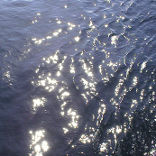
2 THE NORTH-EAST ATLANTIC
The vast OSPAR area covers a wide range of ecosystems reaching from the ice-bound high Arctic in the North to the sub-tropical Azores in the South, from densely populated and highly industrialised coasts in the East to the deep seas of the wide open Atlantic ocean in the West. The physical system exerts a strong control on the ecosystems of the OSPAR area, including the occurrence of species and habitats and their interactions. It also plays a key role in the type and degree of human pressures resulting from the use of living and non-living marine resources which provides a wide range of goods and services of economic value to OSPAR countries. Knowledge about the biodiversity of the marine ecosystems is essential as basis for their sustainable management.
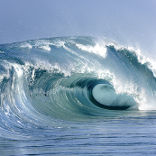
3 CLIMATE CHANGE
Climate change effects and ocean acidification are now evident, especially in the northern OSPAR Regions.
- Surface water temperatures have risen since 1999. Water in the North Sea has warmed 1 to 2 °C since 1985.
- Warm-water plankton and some fish species are shifting northward. This could affect entire ecosystems.
- Ocean acidification could have significant impacts on calcareous organisms. There are likely to be ecosystem-wide effects by 2050, perhaps even in the coming decade in the Arctic.
- Winter Arctic sea-ice extent has fallen 2.5% per decade since 1979, reducing ice-associated habitat and opening new areas of ocean to human uses.
- Sea level is rising, making low-lying coasts vulnerable to flooding and coastal erosion.
The QSR recommends that OSPAR cooperates internationally to monitor the effects of climate change and ocean acidification, and to help develop marine policies that encourage mitigation of climate change and acidification. Where possible, policies should also facilitate adaptation.
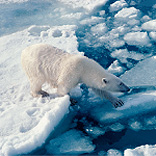
4 EUTROPHICATION
Nutrient inputs have generally decreased, but the OSPAR objective of no eutrophication will not be reached by 2010.
- Large areas of the North Sea coast, and some estuaries and bays in the Celtic Seas, Northern Brittany and Bay of Biscay remain eutrophication problem areas.
- Nutrient discharges to eutrophication problem areas have substantially reduced compared to 1985 for phosphorus (up to 85% lower), but less so for nitrogen (up to 50% lower).
- Farming contributes almost two-thirds of waterborne nitrogen reaching problem areas in the North Sea and Celtic Seas. Progress in controlling this source has been slow.
- Nitrogen inputs from the atmosphere remain high and air emissions from shipping are increasing.
- It can take decades for ecosystems to respond to the reduction of nutrient releases.
The QSR recommends setting targets to reduce nutrient inputs to individual problem areas and urgently implementing existing measures to reduce them.
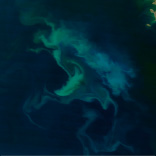
5 HAZARDOUS SUBSTANCES
Concentrations of some substances have decreased, but problems remain in many coastal areas.
- A third of OSPAR’s 26 priority (groups of) chemicals are expected to have been phased out by 2020. More effort is needed to move towards the cessation target for releases of the remaining priority chemicals.
- Adverse effects of the anti-fouling agent tributyltin (TBT) are still seen in four of the five OSPAR Regions, but are decreasing everywhere in response to the global ban.
- Levels of cadmium, mercury, lead, polycyclic aromatic hydrocarbons (PAHs) and polychlorinated biphenyls (PCBs) are unacceptable in fish, shellfish and sediment in many coastal areas.
- Persistent organic pollutants (POPs), such as brominated flame retardants, are widespread and accumulating in marine life, partly as a result of atmospheric transport.
- Biological effects of hazardous substances, such as endocrine disruption, are not well understood.
The QSR recommends continued abatement at source, further promotion of global controls on POPs and mercury emissions, and improving knowledge of hazardous substances and their biological effects.
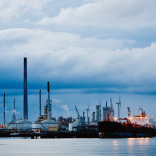
6 RADIOACTIVE SUBSTANCES
Discharges of radionuclides from nuclear installations have fallen, and radiation doses to humans and marine life from this pollution are low in all OSPAR Regions.
- On average, β-activity discharges from nuclear installations are down by 38% since 1995.
- Levels of radioactive substances in the marine environment have dropped in the Celtic Seas and some areas of the North Sea.
- Releases of technetium-99 from the Sellafield reprocessing plant (UK) have been drastically reduced.
- Produced water from offshore oil and gas extraction is a substantial source of α-activity discharges, but their trends and impacts have not yet been assessed.
The QSR recommends continued effort to reduce radioactive discharges from the nuclear sector, and further assessment of radioactive discharges and impacts from the oil and gas industry in order to identify and implement appropriate management measures.
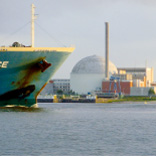
7 OFFSHORE OIL AND GAS INDUSTRY
Pollution from oil and gas production has fallen, but continued monitoring is essential as the industry changes and develops.
- The oil and gas industry is important in the North Sea and is expected to increase in Arctic Waters.
- Oil discharges to water have fallen by 20% on average in the OSPAR area since 2000, with most countries meeting OSPAR’s reduction target of 15%.
- The number of small oil spills (<1 tonne) has decreased.
- The discharge of organic-based drilling fluids has largely ceased since 2005.
- Environmental impacts around some installations have improved, but the evidence is limited.
The QSR recommends a risk-based approach to managing discharges of produced water, improved environmental assessment, and consideration of how existing measures can be applied in the Arctic.
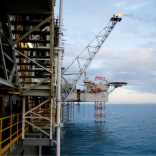
8 FISHING
Fishing has large impacts on marine ecosystems despite improvements in management.
- Exploitation of many stocks continues to be beyond sustainable levels, while the status of a large number of stocks still cannot be fully assessed due to lack of data.
- Depletion of key predator and prey species and disruption of food webs are worrying ecosystem effects of fishing. Discards need to be addressed as a priority.
- The by-catch of non-target fish, seabirds and marine mammals in OSPAR Regions II, III and IV is a concern.
- International cooperation has reduced illegal, unreported and unregulated fishing in several areas.
- Damage to seabed habitats is extensive but protection of deep-sea cold-water coral reefs has improved.
The QSR recommends cooperation to promote sustainable fishing, as well as improved monitoring and assessment of fisheries, by-catch and vulnerable habitats, particularly in the Wider Atlantic where knowledge is poor.
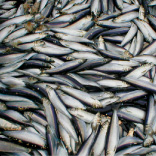
9 OTHER HUMAN USES AND IMPACTS
There are multiple pressures on the marine environment, and many are increasing.
- Offshore renewable energy, mineral extraction, shipping, mariculture and coastal defence reinforcement are making increasing demands on marine space and resources, especially in the North Sea and Celtic Seas.
- The broadscale environmental impacts of individual activities such as offshore wind farms are unclear.
- A better understanding is needed of the combined pressures from all these activities, which should be managed in an integrated manner as is already done in some OSPAR countries, such as Norway.
- Many activities increase the amounts of noise, litter and non-indigenous species affecting the marine environment. The cumulative impacts on marine ecosystems, especially of noise and litter, are still unclear.
The QSR recommends implementing regionally coordinated management plans, backed up by research on the impacts of different activities. New and existing uses of the sea must be continually monitored and their impacts assessed. Where necessary, management measures should be applied.
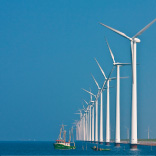
10 BIODIVERSITY AND ECOSYSTEMS
The decline in biodiversity is a long way from being halted.
- All OSPAR Regions have threatened and/or declining species. These include sharks, skates and rays, turtles, seabirds, whales, seahorses, invertebrates, and diadromous and commercial fish species.
- Human activities threaten the extent and condition of several seabed habitats, with fishing a key pressure.
- Climate change will increase the challenge of protecting and conserving biodiversity.
- 159 marine protected areas cover 13% of territorial waters, but just over 1% of the whole OSPAR area.
- Better monitoring of marine biodiversity both in the wider environment and in protected areas is needed.
The QSR recommends extending the OSPAR network of marine protected areas, especially in key areas away from coasts, to complete an ecologically coherent network. Targeted measures are needed to improve the protection of threatened and/or declining species and habitats.
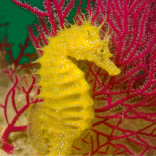
11 TOWARDS ECOSYSTEM ASSESSMENT
Sustainable management of the sea requires combined knowledge of the status of biodiversity and the cumulative impacts of human activities on ecosystem functioning.
- OSPAR has well-developed tools to assess the impacts of the main human activities under its Strategies, but still lacks tools for putting this into the context of overall ecosystem functioning.
- OSPAR has developed a set of Ecological Quality Objectives (EcoQOs) which begin to define the ecosystem health of the North Sea. Most are not yet met although there is progress.
- A regional pilot assessment provides important lessons for developing methods for ecosystem assessment.
The QSR recommends strengthening existing OSPAR monitoring and assessment capacity and integrating it into methodologies for an overarching ecosystem assessment which will seek consistency with developments under the EU Marine Strategy Framework Directive.
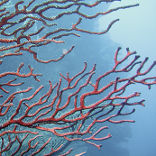
12 REGIONAL SUMMARIES
There are clear signs of improvement in the marine environment of the North-East Atlantic as a result of OSPAR’s efforts. Inputs and contamination levels of some pollutants have dropped and there are signs that some adverse effects are lessening. But the loss of biodiversity has not yet been halted, with fishing and other human activities needing careful management.
Climate change and ocean acidification present major environmental challenges over the long term in all OSPAR Regions. Impacts on Arctic biodiversity are imminent with loss of sea-ice habitat. Pressures arising through climate change are set to grow in all five Regions and will interact with pressures from human activities.
Status in relation to the OSPAR Strategy objectives in each of the OSPAR Regions is different. Progress in delivering OSPAR's objectives is essential for the maintenance of ecosystem integrity and resilience against human pressures and climate change and ocean acidification.
